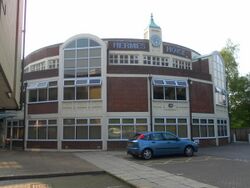Organization:Freight Transport Association
The Freight Transport Association (FTA) based in Tunbridge Wells is one of the largest trade associations in the UK, with members moving goods by road, rail, sea, and air. Its mission is to represent the views and interests of over 13,000 companies from the transport industry: from large multinationals and household names to small and medium businesses.
FTA policy is decided by its members from all modes, through its quarterly regional and national councils. National Councils comprise the British Shippers Council, the Rail Freight Council, the Road Freight Council, and the Freight Council.
The FTA also provides members with services that help them to operate safely, efficiently, and in an environmentally sustainable way.
History
Following the 1888 Railway and Canal Traffic Act traders were given a right of complaint to the Board of Trade if they felt that railway rates or services were unreasonable. That resulted in an influential group of traders coming together in July 1889 and creating an organisation called the Mansion House Association on Railway Rates. Amongst its first members were Mr J J Colman of Reckitt & Colman, and a Mr Thomas Blackwell of Crosse and Blackwell.
The arrival of the internal combustion engine led to the formation in 1904 of the Motor Van and Wagon Users' Association, which changed its name to the Commercial Motor Users' Union in 1907.
In 1921 the third and final segment of the FTA was formed - the Traders' Co-ordinating Committee on Transport.
Over the years the work of the Mansion House Association expanded into more road orientated matters and in 1931 changing its name to the Mansion House Association on Transport.
In 1944 the Commercial Motor Users' Association decided that each of its constituent sectors needed its own identity and was reformed into three organisations. The own-account sector became the Traders' Road Transport Association.
In 1964 the Mansion House Association changed its name to the National Traders' Traffic Association and finally, in 1969, the three groups - the Traders' Road Transport Association, the Traders' Traffic Association and the Traders' Co-ordinating Committee - joined together to become the Freight Transport Association.
In 1979 the group was further strengthened when the British Shippers' Council representing exporters and importers, became a part of FTA.
Research
FTA conducts research and reports which are of use to its members, legislators and policy makers. Of particular note is the Quarterly Transport Activity Survey, increasingly used by government and the public policy arena as an economic performance indicator.
Organisation
FTA National Executive Board
Leigh Pomlett (President) - CEVA Group
Rebecca Jenkins (Vice President) - Greater Than
Jon Moxon (Honorary Treasurer) - Palmer and Harvey
Kevin Appleton - Horizon Platforms Ltd
Ray Ashworth - DAF Trucks
Vincent Brickley - Tandem Transport Service
Andrew Haines - Tate & Lyle
Graham Roberts - Hellenic Carriers
Ian Stansfield - Asda Logistics Services and Supply Chain
Ian Veitch - Yusen Logistics (Europe) BV
Laura Thomas - Birketts LLP
Perry Watts - DHL Supply Chain
David Wells - Freight Transport Association
John Williams - Maritime Transport
Carole Woodhead - Hermes
FTA personnel
David Wells – Chief Executive
James Hookham – Managing Director of Communications & Policy
Trevor Cooke - General Manager Safety, Health, Environment & Quality
Sally Thornley – Director of Compliance
Chris Welsh – Director, European and Global Policy
Karen Dee - Director, National and Regional Policy
Nigel Smart - Director of IT & Development
Philippa Attwood - Director of Marketing and Communications
Campaign for Safe Road Design
In July 2008 the FTA became a partner in the Campaign for Safe Road Design which is calling on the UK government to make safe road design a national transport priority.[1]
References
- ↑ "SAFE ROAD DESIGN TO SAVE UK £6BN EVERY YEAR" (Word DOC). Campaign for Safe Road Design. Archived from the original on 2008-10-30. https://web.archive.org/web/20081030004353/http://www.saferoaddesign.com/media/2024/safe%20roads%20final.doc. Retrieved 2008-10-01.
External links


